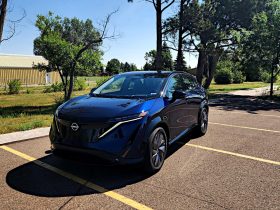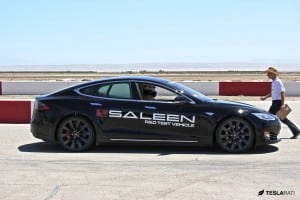 The world of electric vehicles (EV) is an odd one at best. While mainstream manufacturer lament and cry foul, pressuring governments to lower emissions standards, lobbying with deep pockets while trying to paint a green face with scant results to show for, startups have taken advantage of the situation. These new companies thumb their noses at the reluctant and desperately out of time car industry, driven by a model business model at odds with EV’s inherent lack of maintenance needs. We’ve been asking for more efficient cars that don’t pollute when driven. And today we can buy solar panels and other renewable energy systems to power EVs that polluted once at manufacturing, as well as their battery packs. Thankfully Lucid Motors, NextEV and to a certain extend Faraday Future are delivering.
The world of electric vehicles (EV) is an odd one at best. While mainstream manufacturer lament and cry foul, pressuring governments to lower emissions standards, lobbying with deep pockets while trying to paint a green face with scant results to show for, startups have taken advantage of the situation. These new companies thumb their noses at the reluctant and desperately out of time car industry, driven by a model business model at odds with EV’s inherent lack of maintenance needs. We’ve been asking for more efficient cars that don’t pollute when driven. And today we can buy solar panels and other renewable energy systems to power EVs that polluted once at manufacturing, as well as their battery packs. Thankfully Lucid Motors, NextEV and to a certain extend Faraday Future are delivering.
Add to this that most car buyers are fed up, torn between the kitchen and the sink and efficiency, something that cannot happen with a traditional gasoline and diesel. We want a $15,000 Ferrari-like performance car, that is luxurious and doesn’t pollute, to sooth our conscious. While startups, including Tesla, itself no longer a startup, offer cars well above the $60,000 brake point tease new car buyers with what they hope to afford, I say, thank goodness for Lucid Motors, NextEV and to a certain extend Faraday Future, for hyper EVs!
The Decade of the Hyper EVs
Although we have Tesla to thank for showing automaker that EV do work and work very well indeed, other startups decided to continue pushing EVs. I was fortunate to be at the Model S P90D unveiling which was a great break for the EV community. What Tesla now offers with its Model S P100D is a serious blow to exotic gasoline carmakers. A 0 to 60 MPH achieved in no less than 2.275507139 seconds. This means that until 60 MPH, the Model S P100D beats the big three, Ferrari’s LaFerrari, the Porsche 918 and the McLaren P1.
For the past few years, a decade of hyper EVs has invaded our radar. 1,000 HP behemoths regularly are ushering the eventual demise of the antiquated, highly inefficient opposing piston internal combustion engine (ICE). Rimac’s Concept_One is probably the best example to date. In order to keep up with efficiency, power and emission standards, exotic carmakers have had no choice but to adopt what they once ridiculed, the electric motor!
The Lucid Motors Air Hyper EV, Closer to Reality
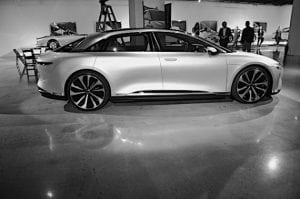
One company that struck a very high cord is Lucid Motors with its 1,000 HP Air. I wrote about our test ride on CleanTechnica. My initial test ride was nothing short of phenomenal.
While many too easily dismiss new players, you’d be pleased to know that Peter Rawlinson, Chief Technology Officer at Lucid and David Moseley, Director of Powertrain at Lucid are no strangers to the EV world. Both were part of the Tesla original battery design team when there were no experts. They wrote the book on battery pack design and management. Peter also played a big part in designing the Model S.
What we experienced in the cramped parking lot of the Los Angeles Petersen Museum was a chassis that was designed in less than two years with a team of 300 people that negotiated an upward spiral ramp at 25 MPH. This chassis hasn’t been fully sorted out yet and was riding off the shelves Pirelli tires!
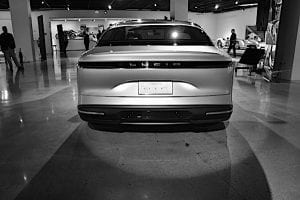
The company just announced a tuned down version of its Air would be available at $60,000. Tesla hasn’t responded yet. In fact, it retired the Model S 60 that could be unlocked to 70 kWh. Lucid Motors plans to make the Air in two years, which might seem optimistic, but considering what they achieved so far leads me to think, they just might do.
Lucid Motors was once called Aetiva, the company that now designs the battery packs for Formula E. It’s fair to say the company has a bit of experience when it comes to designing EVs.
NextEV, Starting With the Driver
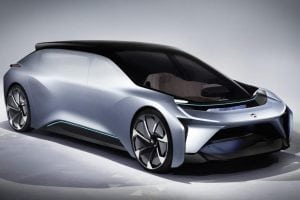
The other hyper EV company is NextEV, also not a stranger to the Formula E world where it races its team with associates.
NextEV also spun out its car manufacturing called NIO. The NIO promises to knock our proverbial socks off with its Eve. This EV was designed starting with what the driver wants. Autonomous when needed, performance and space. Unveiled at SXSW, the Eve will be available self-driving cars in the U.S. by 2020, according to Padmasree Warrior, the company’s United States CEO. Although Warrior has no formal automotive background, her technical expertise and track record is impressive as you can see from her LinkedIn profile.
The NIO Eve says it will give us luxury and performance at a Toyota price. That is something I can look forward to.
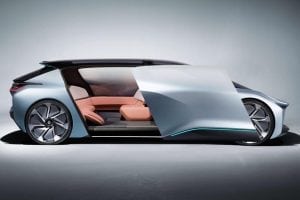
Faraday Future, Will They Deliver At Last?
Faraday Future. otherwise known as FF is a U.S.-based startup backed by Chinese billionaire Jia Yueting and his LeEco empire. Although Jia has just retired citing health concerns, I wouldn’t write off FF too quickly. Sure the company suffered two embarrassing CES unveilings, but Nick Sampson, who is in charge of R&D is no stranger to the automotive world. This company also packs a lot of talent. I’m still hoping it will deliver, although credibility time is running out.
Thank Goodness For Hyper EVs
I’ve been feeling bored with modern cars. While those hyper EVs are non-obtanium for me, they most liklely will be tomorrow’s common cars. Much as the first performance gasoline race technology made its way into regular cars one hundred years ago, hyper EVs will as well. And although they are not very affordable, neither were gasoline cars one hundred years ago.
Personally, I’m thankful to see hyper EVs shake the automotive world that seems to still be very complacent, left alone in a never ending race for bigger, more bloated and not terribly exciting cars with little efficiency improvements. If it takes a global economic crash to get these companies moving, than I’m thankful to see hyper EVs doing just that.






